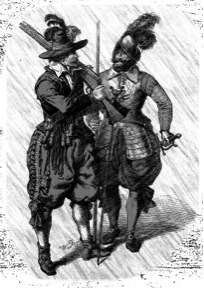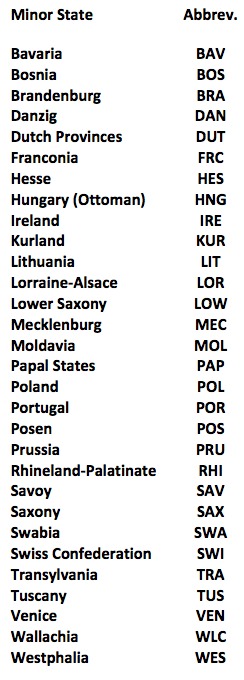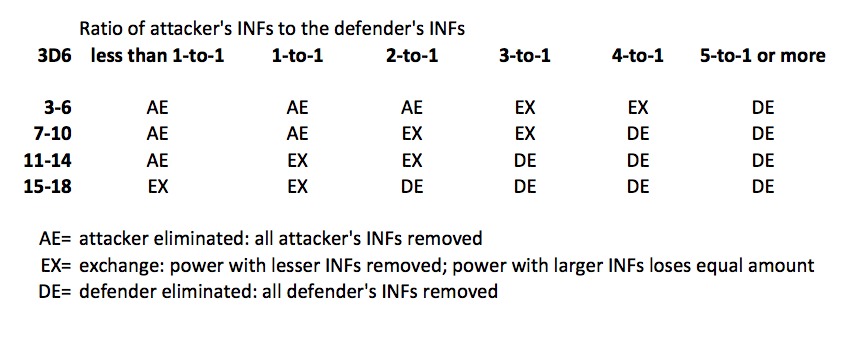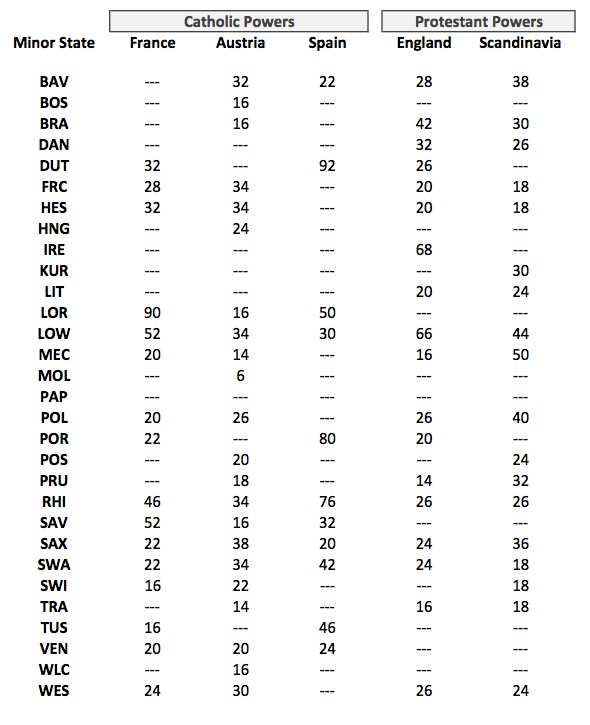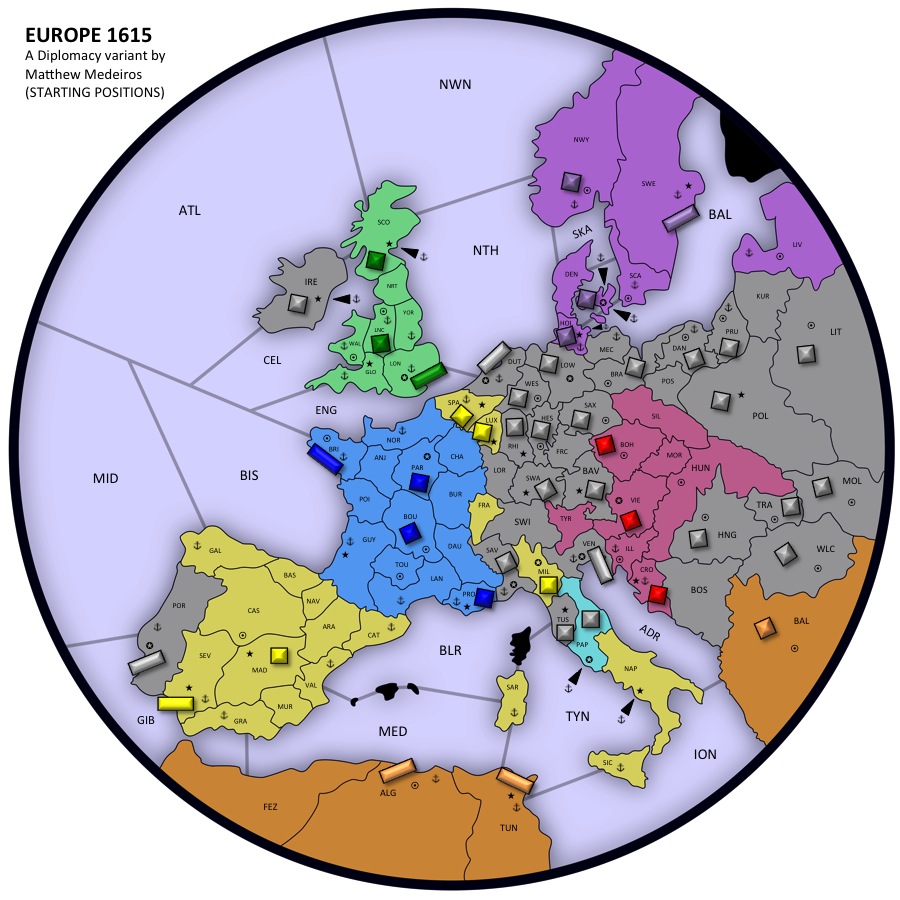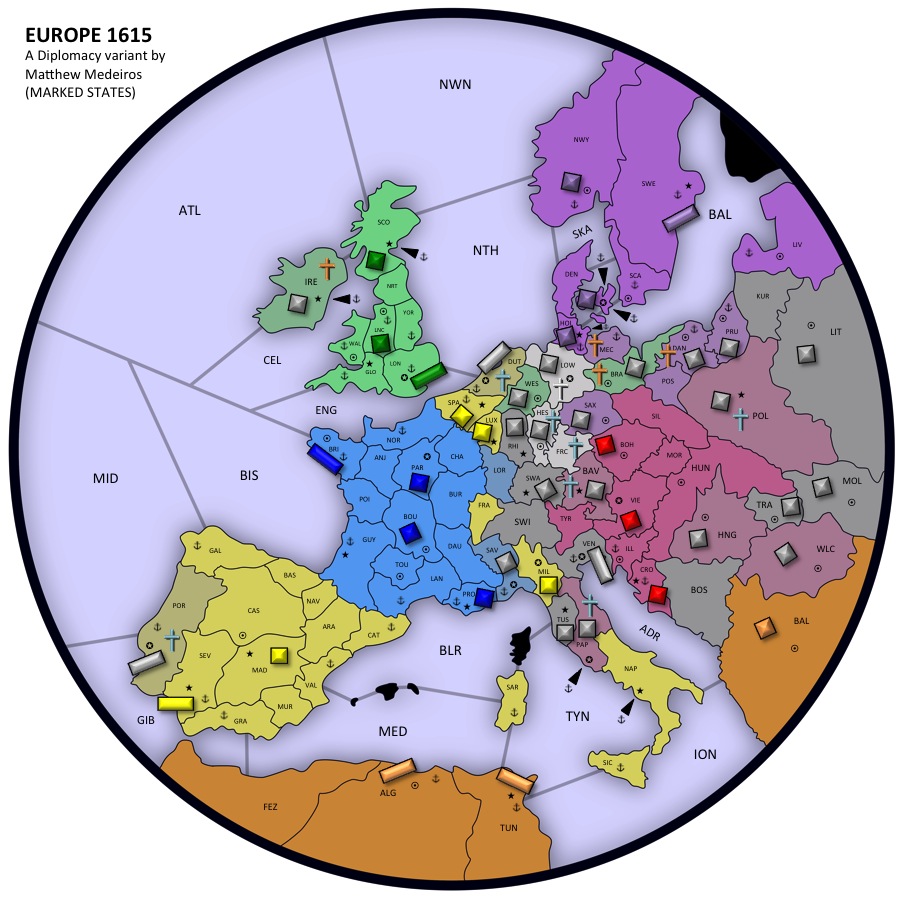Europe 1615: Prelude to War
EUROPE 1615: PRELUDE TO WAR
A DIPLOMACY VARIANT
by Matthew Medeiros
[Play-testers needed! Any comments or questions please write to medeiros412@aim.com, thank you.]
INTRODUCTION
Early in the 17th century, Europe was embroiled in a political and religious war that historians have called the Thirty Years War, a war that culminated in a large number of casualties from battle, famine, and plague. It has been described as a clash between the Protestant factions of Germany and the Austrian and German Catholics, yet from another perspective it has been viewed as the continuation of an age-old struggle of dominance between the kings of France, the princes of Germany, and the Habsburgs of Austria.
The Europe 1615 Diplomacy variant allows players to take the reigns of one of the great powers of the time most closely involved with the Thirty Years War which commenced in 1618: Austria, France, Spain, England, and the Scandinavian Kingdoms (Denmark and Sweden). For the purposes of this game, Denmark and Sweden are treated as in a permanent alliance and controlled by one player. The interaction of these great powers with each other and with the German and Italian states, vassal states of the Ottoman Empire, and other minor states will define the course of the game. The game begins in 1615 with a political and religious influence phase, but military operations do not begin until 1616. The variant adapts rules from a distant game of diplomacy called Origins of World War 1 (and 2). Game is played on two levels: military and political.
During the game, players deploy influence factors (INFs) and initiate diplomatic attacks to secure religious and political control over the minor states. This can impact the movements of units in the game, and victory points are assessed on both levels giving several possible paths to victory for each player. To round out the mechanics of this variant, there is the use of ports to limit the activities of the fleets, variable-valued supply centers, and rules that affect build sites. Victory is measure by the gain and loss of victory points (VPs) through various facets of the game (military and political objectives). Game runs for a time limit determined by the GM and agreed upon by the players. Each game year beginning with 1617 consists of a politics/religious influence phase, and 3 movement/retreat phases and a build phase.
Standard 5th Edition rules of Diplomacy apply with modifications as described below.
PHASES OF THE GAME YEAR
Each game year is divided into the following phases:
1- Political and Religious Influence Phase
2- Diplomatic Attacks
3- Spring Movement and Retreat Phase
4- Fall Movement and Retreat Phase
5- Ownership/Build/Adjustment Phase
POLITICAL AND RELIGIOUS INFLUENCE PHASE
At the start of the game, year 1615, each power receives a number of influence factors (INF) to use for influencing the minor states. INFs represent the time, funds, and diplomatic efforts devoted to a particular foreign policy. For subsequent years, beginning with 1617, the powers receive the INFs based on the table below regardless of supply center count.
Table of INF Allocation Per Year
The table below shows the number of INFs received by each power for the given year.
During this phase, each player establishes influence over the minor states by distributing some or all the INFs. Any unused INFs are placed in the power’s home box, saved for later use. However, in the first year, each player must distribute all INFs, with a minimum deployment of 5 INFs in a selected minor state, and a maximum of 25 INFs. Players should discuss placement of INFs before submitting their deployment list to the GM.
For subsequent years, a power can place any amount of INFs in a minor state. Additionally, a power may place INFs in another power’s home box (purpose is explained below). Points accumulate each year and change with the results of the “diplomatic attacks” (as discussed below). Points placed in the home box may be re-deployed in following years. However, those points already deployed cannot be moved. A listing of the minor states that may be influenced is given below.
List of Pliant Minor States
Note: The Catholic powers, only, may deploy INFs to the Papal states.
Diplomatic Attacks
Note: Diplomatic attacks are not performed in the first year.
The GM publishes the distribution of INFs in the first year to present the statuses of the minor states. For subsequent years, players have a chance to review and negotiate over the INF distribution, and may choose to perform diplomatic attacks. Each player may choose to conduct a diplomatic attack only once per phase against INFs of another power in one minor state. The player chooses a state where he/she has invested INFs, and then directs an attack against any other player’s INFs also present in that state (one attack against another power). Additionally, if 7 or more INFs of one power have been placed in another’s home box, the power has earned diplomatic immunity. With diplomatic immunity, a power is protected from diplomatic attacks from the power where INFs have been placed. Diplomatic immunity is reciprocal; neither power will be able to diplomatically attack each other as there is an understanding over diplomatic affairs of the state. To negate the effect of diplomatic immunity, the affected power must eliminate or reduce the number of INFs of the opposing power to 6 or less with diplomatic attacks.
The decisions of the players are then communicated at the same time to the GM, much like the simultaneous submission of orders for units. Each player submits multiple orders to perform diplomatic attacks, where each order indicates the name of minor state and the target of the attack, but only one will be followed for reasons described below. Diplomatic attacks are submitted in secret to the GM, however, players may discuss these attacks, may make promises, but no one is obligated to adhere to any agreements.
The national order of attacks is dependent on the number of INFs received for the year, basically, from least to greatest. Therefore, in 1617, the order is: (1) Spain, (2) France, (3) Scandinavia, (4) England, and (5) Austria. By 1621, the order will change to: (1) Spain, (2) England. (3) Austria, (4) France, and (5) Scandinavia. In case of ties, follow the order of the previous year.
GM consults the Diplomatic Attack Table shown below, to determine outcome of the attacks. Additionally, for the year 1617, the French player must submit an alternative order because it is possible that the first ordered attack cannot be performed due to a loss of INFs from a Spanish diplomatic attack. The Scandinavian player must submit 2 alternative orders if the first ordered attack cannot be performed due to a loss of INFs from a French and/or Spanish attack. As such, the GM consults the first alternative order of Scandinavia, and if this is not doable the GM consults the second alternative order. England must submit 3 alternative orders, and Austria must submit 4, for similar reasons. Since Spain goes first in the national order of the diplomatic attacks, there is no need for Spain to submit alternate orders.
Diplomatic Attack Table
Diplomatic attacks are determined by a random throw of 3 six-sided dice. If players are uncomfortable with accepting the GM’s account of “unseen” dice rolls, players and GM may utilize stock market prices for a given day as a means of generating random numbers. Note: In the case where the ratio of INFs of the attacker to the defender is equal to or greater than 5-to-1, then no roll is performed, and defending INFs are removed.
Optional Approach to Diplomatic Attacks
Since diplomatic attacks introduce a random element to the game, they may be handled by resolving all attacks with an exchange (EX). This negates the use of dice rolls to resolve the attacks. The use of this method should be decided at the start of the game and agreed upon by all players.
Political Mark of the Minor States After the Influence Phase
At the end of the diplomatic attack phase the following is considered:
(1) Political status of the minor state is not established if there are less than 5 INFs present.
(2) Political status of the minor state is NEUTRAL if no single major power holds 60% or more of the total INFs present in the minor state.
-or-
(3) Political status of the minor state is ALIGNED if a single major power holds 60% or more of the total INFs present in the minor state, and has invested minimally 5 INF. Minor states marked as ALIGNED are essentially in allegiance with the major power holding the most influence as specified above.
Religious Mark of the Minor States After the Influence Phase
The combined INFs remaining for England and Scandinavia represent the political influence of the Protestant factions in the province. The combined INFs of Austria, France and Spain represent the political influence of the Catholic factions in the province. Control of a province by either the Protestants or Catholics is determined by the following:
(1) Religious status of the minor state is not established if there are less than 9 INFs present.
(2) Religious status of the minor state is TOLERANT if no single religious faction holds 75% or more of the total INFs present in the minor state. (TOLERANT would suggest that the government and populace are composed of both Protestant and Catholic members. The minor state is not swayed in any particular direction.)
-or-
(3) Religious status of the minor state is CONTROLLED if a single religious faction holds 75% or more of the total INFs present in the minor state, and a minimum of 9 INFs are present for that faction. (CONTROLLED refers to nearly exclusive dominance of one religion in the government and populace.)
Benefit of an ALIGNED Minor State
If the political status is ALIGNED, the major power that holds the 60%-or-more majority of INFs in the state is afforded the benefit of submitting HOLD or SUPPORT orders to the minor state's unit.
Rules Concerning Political Status of Minor States
(1) If the political status is not established, any major power may attack and occupy the state.
(2) If the political status is NEUTRAL, no major power can attack or enter the minor state as it violates the neutrality status. This also applies to retreating units: a retreating unit cannot enter a neutral state. Neutral units cannot receive support. Treat NEUTRAL minor states much like the impassable Switzerland of standard Diplomacy. Note: GM will always remind players if a neutrality violation will occur with orders submitted, and will request changes. If no changes are submitted then those orders that will cause a violation will be adjudicated as FAILED.
-or-
(3) If the political status is ALIGNED, the major power (to which the minor state is ALIGNED to) is not allowed to attack/dislodge the minor state's unit, however, the major power may SUPPORT the unit (other powers may SUPPORT the unit as well). If no unit is present in an ALIGNED minor state, any major power may enter freely.
Note: A power cannot dislodge or support the dislodgment of its ALIGNED minor state's unit, even if that dislodgment is unexpected.
Contestation: If the minor state's unit is attacked/dislodged by a foreign power and thus disbanded, the aligned major power (or any other power for that matter) is given the right to attack the occupying foreign unit. In such a situation the minor state will be marked as CONTESTED.
Occupation of the Minor States
If a major power attacks and occupies a minor state that does not have a status or is marked as ALIGNED with another power, followed by change in ownership at the build phase (occupying power maintains its position in the minor state before the build phase), then no major power may place INFs in that state during the coming political and religious influence phase (the state ceases to be a pliant state). The minor state is now considered the DOMINION of the occupying power.
Objectives: Victory Points Based on Religious Status of the Minor States
Victory points are awarded at the end of the game depending the religious status of the minor states as shown in the Objectives Table and VP Awards. It is important to note that this rewards system only applies for minor states that have not become DOMINIONS of a major power. It will be up to the player to weight the benefits of occupying/dominating a minor state versus supporting its position and alignment.
Objectives Table and VP Awards (VPs based on Religious Control)
Explanation and Examples
Reviewing the table above: If at the end of the game Saxony is Catholic controlled, then Austria can garner 16 VPs for the religious status as long as the state is ALIGNED towards Austria, and not a DOMINION of Austria (or any other power for that matter). If Saxony is ALIGNED with France, then only France can garner 22 points at the end. To prevent France from obtaining VPs, Austria must invest INFs in Saxony to try and alter the alignment. For NEUTRAL minor states under Catholic control, all Catholic powers that have invested INFs in the minor state will earn VPs at the end of the game. The same is true for the Protestant powers that have invested in NEUTRAL states under Protestant control.
MOVEMENT PHASE: RULES CONCERNING FLEETS AND ARMIES
Orders are submitted in the same manner as in standard Diplomacy. A HOLD or a SUPPORT order can be submitted to units in minor states that are ALIGNED with a player's power.
Fleets can only move into or support a move into a coastal province that has a port (anchor). Fleets are allowed to convoy armies to any coastal province whether or not a port is present. Certain orders on fleets are deemed illegal based on the location of the port. These are given below:
F(ADR)-PAP
F(ADR)-NAP
F(NTH)-HOL
F(SWE)-SKA
F(NTH)-DEN
F(ATL)-SCO
F(ATL)-IRE
F(CEL)-SCO
(These orders are also not legal in reverse.)
Additionally, certain army movements are allowed without the use of a convoy, and given below:
(1) movement and support between GRA and FEZ.
(2) movement and support between SIC and NAP.
(3) movement and support between IRE and SCO
(4) movement and support between SCA and COP
Units of minor states that are dislodged are immediately disbanded.
OWNERSHIP/BUILD/ADJUSTMENT PHASE
The player occupying a major power's supply center prior to the build phase may waive the change in ownership of the center. This may be arranged by the player (and communicated to the GM) to avoid depriving a center from an ally. Once the decision is made no reversal is allowed until the next build phase. Note: The option to waive ownership of a supply center does not apply to the supply centers of minor states.
Each supply center controlled during the build phase provides the resources to field 1 army or 1 fleet (as in standard diplomacy). Players may build new units on any unoccupied home center, if it is still under control. Owned home ports may be used as a build site for fleets whether or not it is a supply center.
If a supply center of a minor state is unoccupied and has yet to become a DOMINION of a major power, a new unit is built.
STARTING POSITION OF UNITS
France: A(PAR), A(BOU), A(PRO), F(BRI)
Spain: F(SEV), A(MAD), A(LIE), A(MIL), A(SPA)
Austria: A(BOH), A(CRO), A(VIE)
England: A(SCO), F(LON), A(LNC)
Scandinavia: F(SWE), A(COP), A(HOL), A(NWY)
Starting Deficit in Unit Count: All major powers begin with two units less than the number of supply centers available. If there are no losses in supply centers by the build/adjustment phase of 1616, then each major power is entitled to two new builds.
Each pliant minor state begins with a unit with exception to SWI, POS, FRC, KUR, MEC, BOS, and LOR. Venice, Portugal, and the Dutch Republic begin with and maintain fleets. Of the Barbary States, TUN and ALG begin with and maintain fleets (these units are in permanent HOLD throughout the game), and the Ottoman Balkans has a unit (also in HOLD throughout the game). These units may be supported.
VICTORY POINTS ADJUSTMENT
Victory is measured by the accumulation of Victory Points (VPs) at completion of the game. Bonuses are received based on the religious/political situations and military operations. Bonuses that affect all powers: (1) gain of a supply center beyond home centers= VP value of supply center, a +3, +9, or +15 as indicated on the map; (2) loss of a supply center= VP value of supply center a -3, -9, or -15 as indicated on the map. Additional bonuses can be garnered at the end of the game for completed objectives. These objectives are listed in the Objectives Table and VP Awards.
Mid-Game VP Assessment: After 3 game years of play, GM will pause the game and calculate total VPs for each player based on the current state of affairs: VPs from captured supply centers, and religious statuses of the minor states. This should help players gauge their progress if rankings are not apparent.
Elimination: Any player who has all supply centers occupied by foreign units is eliminated as in standard Diplomacy. As a result, the player cannot continue receiving nor deploying INFs for the remaining years. However, if there are any remaining minor states (with units) aligned to the eliminate power, the player may continue submitting orders to those units.
VICTORY CONDITIONS
At the opening of 1622, the player with most VPs wins the game. If there is a tie between the two top-ranked players, then the game will resume for another year, and VPs reassessed at the opening of the next year. This will continue until a break in the tie.
Optional: Alliances and Victory: Two players, before the start of 1619, may form an alliance. This is a permanent agreement and is communicated to the GM and declared to the other players. Alliances do not change the rules of the game, but affects victory condition. It is possible for two alliances to form in the game. At the end of the game, an alliance wins if the combined VPs of the two allies exceed the total VPs of the other three players (or the other alliance and the fifth player). Alliances are bound to this rule to the end, so it is possible that a single unaligned player can (1) win the game with a minimum amount of VPs by bringing about a balance of power between two alliances; or (2) exceeding the other two unaligned players in total VPs given the only alliance cannot meet the condition above. Note: INFs cannot be transferred between allies.
Automatic Protestant Victory: Any Protestant power that makes the Papal States a DOMINION achieves instant victory.
HISTORICAL NOTES
Wikipedia entry:- http://en.wikipedia.org/wiki/Thirty_Years'_War.
Britannica entry:- http://www.britannica.com/EBchecked/topic/592619/Thirty-Years-War.
REFERENCES/ACKNOWLEDGEMENTS
History, concepts, and rules adapted from:
Standard Diplomacy by Allan Calhamer
1600 by Tommy Larsson
1648 by Charles Feaux de le Croix
Ambition and Empire by B. M. Powell and Jeff Kase
Formal Diplomacy by E. Sabatine and Edi Birsan
Origins of World War 1 by Jim Dunnigan
Origins of World War 2 by Jim Dunnigan and Thomas Shaw
The Thirty Years War by C.V. Wedgwood
Standard Map and Starting Positions
Sample Map of Marked Minor States:
Sample map of how the religious/politics phase changes the statuses of the minor states and relationship of those states with the major powers.
The new map above was generated after the first political and religious influence phase where each player distributed INFs to the unmarked minor states. This was not followed by diplomatic attacks. As a result: IRE, WES, and BRA are aligned with England, with both BRA and IRE Protestant controlled (orange cross). PRU, DAN, POS, MEC, and SAX are aligned with Scandinavia. MEC and DAN are Protestant controlled. LOW, HES, and FRC are all neutral states, and all are Catholic controlled (blue cross) with exception to LOW which is marked as TOLERANT (white cross). POR and the DUT are aligned with Spain and both Catholic controlled; and BAV, POL, HNG, WLC, and PAP are all aligned with Austria and catholic controlled with exception to HNG, VEN, and WLC. SAV and the LOR are aligned with France. Remaining minors states are left unmarked and may be attacked and occupied by a major power. Now the players must decide how to maneuver units and negotiate agreements in this newly drawn map, keeping in mind the position of neutral states and those states that are aligned to their power. Things to consider: (1) neutral states are impassable; (2) aligned states cannot be attacked/occupied by the major power they are aligned to if the minor state's unit is present. It should be also noted that the unmarked, neutral, and aligned states that are established in the first year may change status in another year where the political/religious influence phase has been assigned. This is to reflect the fluid nature of the minor states as the major powers compete for control.
List of Provinces and Minor States and VP Value
(To be added: Image:provinces_v21.jpg)
